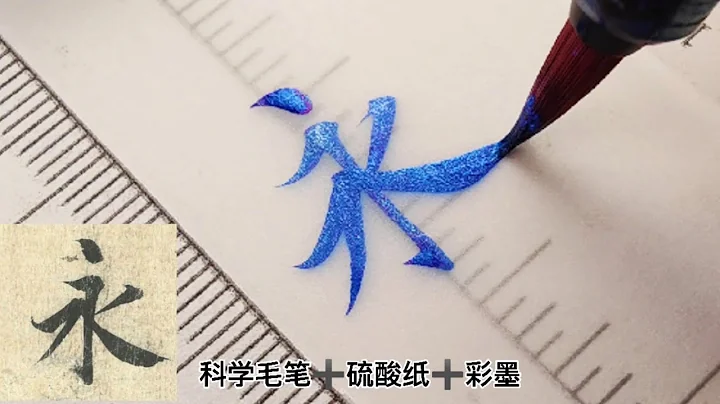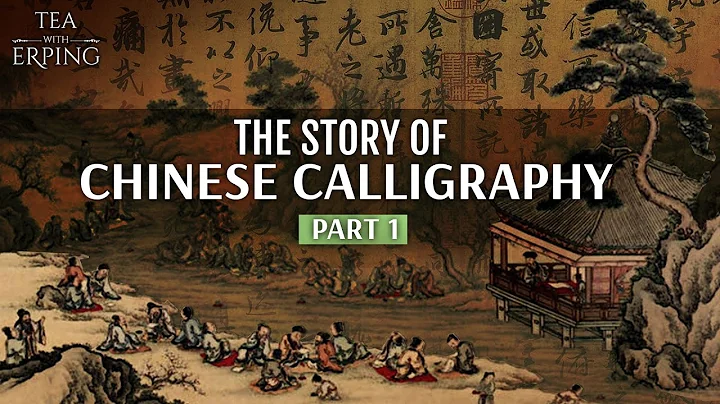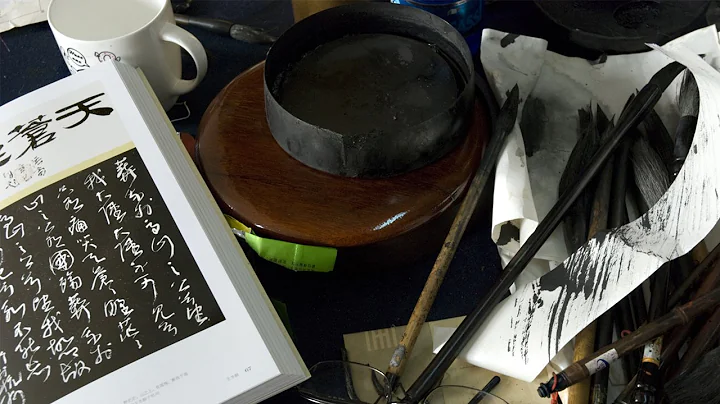How did Wang Xizhi and other big coffees write?
Excerpt from: Zhuang Tianming's "The Flow of Writing"
How to correctly hold a pen is a compulsory course for every beginner in calligraphy and painting. The people who know how to use pens most in history are none other than "Book Sage" and "Painting Sage". How did write? The key project of Nanjing Museum, "Research on Writing in Chinese History" was officially completed. Experts sorted out the changes in writing by overseas Chinese among hundreds of ancient paintings. Experts also found that Wang Xizhi of the Eastern Jin Dynasty and Wu Daozi of the Tang Dynasty may play "二指 Chan" .
The Han Dynasty people hold the brush, as if clenching their fists.
is distinguished by the number of fingers touching the penholder, such as "two fingers", "three fingers", "four fingers", and "five fingers". At the same time, see if the ring finger and little finger are floating, and there is a single hook The difference between double hooks, such as "two fingers single hook", can be described as endless. Zhuang Tianming, the project leader of "Research on Writing in Chinese Past Dynasties" and the former director of the Ancient Art Institute of Nanjing Museum, collected a large amount of image data and analyzed the characteristics of writing in past dynasties and found that the way Chinese people hold pens varies from period to period. . For example, Han Li, who is famous for its Fangzheng and majestic. When writing this font, the people in the Han Dynasty held the pen in a "thick line"-the pen is facing down, and the entire hand grasps the pen shaft, like a fist, called "Grip method".
"In the past, the Han Dynasty people's method of holding pens has always been a mystery. When working on the subject, we found the pictures of people holding pens at that time through direct historical data-the Han Dynasty portrait stone." Zhuang Tianming introduced, a large number of stone carvings indicate The "holding method" was very popular in the Eastern Han Dynasty. For example, on the stone portrait in Linyi, Shandong, Cangjie's pen is the gripping method. According to this speculation, in order to use and promote this writing method at that time, the writing method of the ancestor of writing characters was also imagined and fixed as the gripping method, to show that the gripping method is ancient and orthodox.
The three-finger brush is the most popular, and the two-finger is the best.

Song dynasty Liu Songnian made "Eighteen Scholars Picture", writing method was 041a2d#4 Zhuang Tianming discovered that the two-finger and three-finger single-hook writing method was mainly popular in the Jin and Tang Dynasties to the Five Dynasties; although the single-hook writing method was mainly used in the Song Dynasty, the double-hook writing method gradually flourished, to the Yuan Dynasty single-hook method and double-hook method There was a trend of parallelism; although the single hook method was still used in the Ming Dynasty, the three-finger double-hook writing method was mainly popular; in the Qing Dynasty, there were multiple coexistence of single-hook, double-hook, four-finger, and wrist-returning methods.
"In this long thousand years, the Chinese have always used two or three fingers to hold the brush, and four fingers appeared in the Qing Dynasty."
Zhuang Tianming introduced, the most in the world The common method is the three-finger writing method, that is, the method of holding the thumb, index finger and middle finger together. This is also the method used in modern hard pen writing in China. But this way is not optimal.
How does the famous Wang Xizhi get a pen? In the painting of Qin Qin painted by Gu Kaizhi, a great painter of his time, the characters are clearly shown as a two-finger single hook; while in Song Dynasty Liang Kai's "Wang Youjun Book Fan Picture", Wang Xizhi's writing style is also a two-finger single hook Hook method. Zhuang Tianming introduced that the two-finger writing method is a writing method that uses the index finger as the main body and the thumb as a supplement. It is the simplest and most flexible method of writing. Zhuang Tianming originally used the three-finger method, and after practicing the two-finger single-hook method for several months, he found that "not only does the pen no longer fall, but the sensitivity and flexibility of the pen and the finger are highlighted."

Song Dynasty Liang Kai "Wang Youjun Book Fan Picture", the writing method should be two-finger single hook method

04ab0f#
[Ming] Qiu Ying's "The Literary Girl Picture Scroll" (partial)
The writing method is single hook method

[Ming] Anonymous "A Thousand Autumn Beautiful Pictures"] Part ﹚
This is a drawing image, the writing method is double hook method.

[Ming] Anonymous "A Beautiful Thousand Autumn" (Part)
This is a calligraphy type image, 04a7d writing method is double hook#


[Qingxing] No section of music picture "Ancient Volume"
This is a drawing image, the way of holding the pen is the double hook method
What's the problem with our five-finger pen?
Bring time back to the present. Many people used the "five-finger writing method" when they learned calligraphy in their childhood, that is, all five fingers are in contact with the pen barrel.
Zhuang Tianming's research found that the five-finger writing history is very short, only more than 50 years. He believes that it is the successive release of basic calligraphy textbooks with five-finger pen images in modern times; at the same time, people's writing of calligraphy has changed from hanging wrist writing to wrist arm pillow table writing, and the five-finger method has become the mainstream.
Zhuang Tianming believes that the five-finger writing method that is popular in modern times has obvious shortcomings. "In short, it is complicated and difficult, rigid and inconvenient." He said that now teaching children to learn calligraphy, they should give up the five fingering as soon as possible. Compared with the two fingering, which is the most effective but the most difficult, three fingering is taught to children. More appropriate.


a2714a0d#
a2714a0d#
a2714a0d#
Two or three fingering ([Northern Qi] Yang Zihua's "School Book Picture" Part, Collection of Boston Museum of Art)

[Eastern Han Dynasty] "Master Book Picture"﹙ Part﹚ Mural

[Western Jin Dynasty] "Porcelain Figurines Sitting on Two Books" Unearthed in Changsha, Hunan in the second year of Yongning in 1958
The characters are written with the most common gripping method in the Han Dynasty, and it can be seen until the Western Jin Dynasty that the gripping method still exists

[Eastern Jin Dynasty] Gu Kaizhi's "A Picture of Female History" ( Part) Collection of the British Museum



[Tang] "Send Son to Heaven" (detail) Osaka Municipal Museum of Art Collection
This Image for calligraphy. The picture shows the Chinese official thumb and index finger holding the pen, the middle finger, ring finger and little finger resist each other, and also help the index finger without holding the pen holder. It is a typical two-finger single hook (single bud) style of writing

[Late Tang Dynasty] "Said Picture" [Part] Dunhuang Mural, British Museum Collection
The Bodhisattva and his disciples in the picture are written by the holding pipe method,
may be regarded as popular in the Han Dynasty The legacy of the gripping method

[Five Dynasties] Ruan Gao's "Langyuan Female Fairy Picture" (partial) Beijing Palace Museum Collection
The fairy girl's thumb and index finger write, The middle finger, ring finger and little finger do not hold the penholder, which is a typical two-finger single hook (single bud) style of writing

[Five Dynasties] "Ten Kings of the Earth Store" (detail) ﹚ Dunhuang Relics (English) Collection of the British Museum
The thumb and index finger of the writer in the picture are the typical two-finger single hook method. The thumb and index finger of the left hand are sorting out pens.

[Northern Song Dynasty] Anonymous "Monkey and Mercury Map" (part) Collection of Boston Museum of Art
The writer's thumb and index finger write Obviously, it is difficult to tell whether the middle finger is against the pen. The author speculates that the two-finger single hook method is more likely

[Northern Song Dynasty] Li Gonglin [Biography] "Xiyuan Yaji Atlas" [Part] The 2002 autumn auction work
by Maoshengjia Auction Company shows images of Su Dongpo, Mi Yuanzhang and others. After careful analysis, it can be determined as a single hook French style, but two-finger single hook and three-finger single hook It is not easy to determine

Part of the "Xiyuan Yaji Atlas" part Su Dongpo wrote
seems to be a three-finger single hook method

Part of "Xiyuan Yaji Atlas Volume" Part II Mi Yuanzhang wrote
It seems to be a three-finger single hook method



[Song] Anonymous Writing Title of Luo Han (Original Luohan Title) ) "Chinese Painting" 1985 Issue 3
This is a typical two-finger single hook writing method

[Southern Song Dynasty] Zhou Jichang "Ying Shen Guan Yin" (part) ﹙ The United States﹚Boston Museum of Art Collection
This should be a two-finger single hook type writing method

[Song] Liu Songnian's "Pushing Tea" ( Part) Taipei Palace Museum Collection
This should be a two-finger single-hook style of writing

[Song] Unknown coloring figures (Image of Wang Xi) Taipei Palace Museum Collection
Although the image is not clear enough, it is not difficult to determine that it is a two-finger single-hook writing method

[Ming] "Fuxi Statue" Ming Engraved "Images of Emperors and Virtues in Past Dynasties"
In this picture, Fuxi's thumb and index finger are holding the pen, and the middle finger, ring finger and little finger are idle without holding the pen. It is a typical two-finger single-hook (single bud) style of writing
 11d2 a#
11d2 a#
【明】"Image of Wang Xi" Ming engraved "Portrait of Emperors and Virtues of the Past Dynasties"
In this picture, the book saint's thumb, index finger and middle finger hold the pen, and the ring finger and little finger are curved without twisting the pen. It is a typical three-finger double-hook writing method


[Ming] Du Jin's "Eighteen Bachelor's Picture" (partial)
In this picture, both bachelors have thumbs and index fingers, The middle finger writes, the ring finger and little finger generally do not hold the pen holder (analysis based on the overall situation of the writing in the Ming Dynasty), so it is judged to be a three-finger double hook type writing method

【清】No paragraph " Portrait of Emperor Qianlong's Writing" Beijing Palace Museum Collection
Emperor Qianlong is not only an effective emperor, but also has a special interest in calligraphy. He has a lot of inscriptions and handwritings on famous places in the world. Therefore, as the emperor and calligrapher, his writing is very representative. It can be seen from this work that Qianlong's writing should belong to the three-finger single hook method.


8b0f#
8b0f Image" [Part] Collection of the Palace Museum, Beijing
Emperor Qianlong's writing in this work is different from the previous one, obviously belonging to the three-finger double hook method

【清】Anonymous "Xuanye casual clothes writing portrait" (part)
This writing method is three-finger double hook method

罗振玉著笔
Famous archaeologist and epigraphy Luo Zhenyu (1866-1940) should hold the pen with the palm and vertical five fingers without leaving the table.

Yu Youren writes
Modern Chinese politician, educator, and calligrapher Yu Youren (1879-1964) The writing posture should be the modern popular five-finger writing law.

启功执笔
Mr. Qi Gong used to be the chairman of the Chinese Calligraphers Association, the honorary chairman, the chairman of the National Cultural Relics Appraisal Committee, and the curator of the Central Museum of Cultural History. President of Xiling Seal Society. These prominent positions in the industry show their importance in writing research. Qi Lao's writing is very similar to Shen Yin's. Although he advocates five-finger writing, he often uses two-finger double hooks when he writes. From the two images selected in the calligraphy bar "Mr. Qi Gong's Writing", it can be seen that his ring finger and little finger are not pasted with the pen barrel in the writing, which plays a role of "guide and delivery".

Lin Sanzhi's writing
Lin Sanzhi is a contemporary "calligraphy saint" . In his later years, he used the traditional three-finger single-hook method, which was the same as modern hard pen law enforcement.

[Republic of China] "Science Calligraphy" Illustration
4da1a The "Science Calligraphy" published by the Library (by Chen Gongzhe) illustrated the writing posture emphasizing that "the flesh under the claw of the name finger refuses to face outward" and "the little finger is next to the name finger", which is a typical five-finger writing method. The book had a great influence at the time, and Ding Wenjun, the author of "The Essence of Calligraphy", highly regarded it.
[Modern] "Five-character writing drawing"
This is the writing demonstration drawing in "Standard Copybooks" by Shen Yinji, emphasizing "Xiao, The five-character tactics of "betting, hooking, grid, and retrieving" are the popular modern five-finger writing style.











![Calligraphy⎜Wang XIzhi 王羲之⎜Every Chinese calligraphy lover needs to watch this video⎜ Subtitles [CC] - DayDayNews](https://i.ytimg.com/vi/vAiJiMBkDoc/hq720.jpg?sqp=-oaymwEcCNAFEJQDSFXyq4qpAw4IARUAAIhCGAFwAcABBg==&rs=AOn4CLCHMQa1v9PprHM6SuTT7XXGCS674A)











